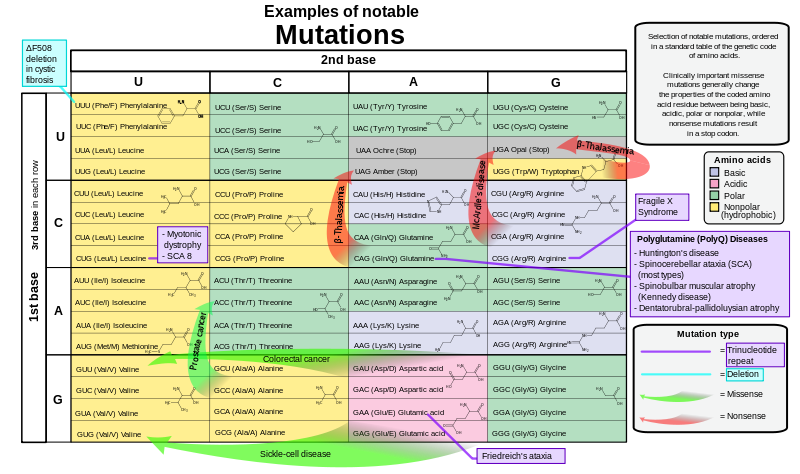| PopisNotable mutations.svg |
English: Selection of notable mutations, ordered in a standard table of the genetic code of amino acids.
As can be seen, clinically important missense mutations generally change the properties of the coded amino acid residue between being basic, acidic, polar or nonpolar, while nonsense mutations result in a stop codon.
In the case of cancers, mutations cause aggravation of the conditions by impairing tumor suppressors or activating oncogenes.
Every U (uracil) in the mRNA corresponds to a T (thymine) in the original DNA. Therefore, mutations are often noted using T rather than U.
Mutations mentioned
- Sickle-cell disease: GAG to GTG in the hemoglobin gene [1]
- Huntington's disease: CAG insertions, which adds a string of glutamines to Huntingtin[1]
- Friedreich's ataxia: In most cases, the mutant frataxin gene contains expanded GAA triplet repeats in the first intron;[2]
- Dentatorubral-pallidoluysian atrophy (DRPLA), caused by an expansion of a CAG repeat encoding a polyglutamine tract in the atrophin-1 protein.[3]
- Kennedy's disease, caused by expansion of a CAG repeat in the first exon of the androgen receptor gene.[4]
- Fragile X Syndrome: CGG insertions on the X chromosome.[1] Practically, however, these are not related to arginine, because the mutations are located in the 5' untranslated region.
- CTG in myotonic dystrophy.[5]
- Spinocerebellar ataxia. Many types are caused by CAG repeats, see Wikipedia:Spinocerebellar ataxia#Treatment and prognosis for details.
- Spinocerebellar ataxia: CTG [6]
- β-thalassemia (β-globin gene)
- C to U resulting in stop signal UAG [7]
- also UGG to UGA[8]
- D1822V by GAC->GTC[9] is the most common missense APC variant described to date in colorectal cancer.[10]
- A49T (GCC to ACC)[11], V63M and V89L[11] are the most common missense substitutions in prostatic or type II steroid 5alpha-reductase gene in prostate cancer tissue.[12]
- p.R50X is the most common nonsense mutation in myophosphorylase in McArdle's disease,[13] the most common Glycogen storage disease
References
- ↑ a b c Kimball's Biology Pages --> Mutations archive copy at the Wayback Machine Retrieved on July 18, 2009. Author: John W. Kimball
- ↑ The Friedreich ataxia GAA triplet repeat: premutation and normal alleles L Montermini, E Andermann, M Labuda, A Richter, M Pandolfo, F Cavalcanti, L Pianese, L Iodice, G Farina, A Monticelli, M Turano, A Filla, G De Michele and S Cocozza. Human Molecular Genetics, Vol 6, 1261-1266
- ↑ Molecular pathology of dentatorubral-pallidoluysian atrophy. I Kanazawa. Philos Trans R Soc Lond B Biol Sci. 1999 June 29; 354(1386): 1069–1074. PMCID: PMC1692599
- ↑ La Spada AR, Wilson EM, Lubahn DB, Harding AE, Fischbeck KH (July 1991). "Androgen receptor gene mutations in X-linked spinal and bulbar muscular atrophy". Nature 352 (6330): 77–9. DOI:10.1038/352077a0. PMID 2062380.
- ↑ Page 88 in: Title: COLOR ATLAS OF GENETICS. Author: CEBERHARD PASSARGE, M.D. ISBN: C1588903362, 9781588903365 Length: 486 pages
- ↑ Molecular genetics of spinocerebellar ataxia type 8 (SCA8) A.K. Mosemillera,c, J.C. Daltona,c, J.W. Dayb,c, L.P.W. Ranuma,c. Nucleotide and Protein Expansions and Human Disease.
- ↑ Mutations By Professor A. Cuschieri.Department of Anatomy. University of Malta. Retrieved on July 18, 2009
- ↑ Page 258 in: Colleen Smith; Lieberman, Michael; Marks, Dawn B.; Allan D. Marks (2009) Marks' Basic medical biochemistry: a clinical approach, Filadelfie: Wolters Kluwer Health/Lippincott Williams & Wilkins ISBN: 0-7817-7022-X.
- ↑ Guerreiro CS, Cravo ML, Brito M, Vidal PM, Fidalgo PO, Leitão CN (June 2007). "The D1822V APC polymorphism interacts with fat, calcium, and fiber intakes in modulating the risk of colorectal cancer in Portuguese persons". Am. J. Clin. Nutr. 85 (6): 1592–7. PMID 17556698.
- ↑ Cleary SP, Kim H, Croitoru ME, et al. (October 2008). "Missense polymorphisms in the adenomatous polyposis coli gene and colorectal cancer risk". Dis. Colon Rectum 51 (10): 1467–73; discussion 1473–4. DOI:10.1007/s10350-008-9356-7. PMID 18612690.
- ↑ a b Hayes VM, Severi G, Padilla EJ, et al. (February 2007). "5alpha-Reductase type 2 gene variant associations with prostate cancer risk, circulating hormone levels and androgenetic alopecia". Int. J. Cancer 120 (4): 776–80. DOI:10.1002/ijc.22408. PMID 17136762.
- ↑ Makridakis N, Akalu A, Reichardt JK (September 2004). "Identification and characterization of somatic steroid 5alpha-reductase (SRD5A2) mutations in human prostate cancer tissue". Oncogene 23 (44): 7399–405. DOI:10.1038/sj.onc.1207922. PMID 15326487.
- ↑ García-Consuegra I, Rubio JC, Nogales-Gadea G, et al. (March 2009). "Novel mutations in patients with McArdle disease by analysis of skeletal muscle mRNA". J. Med. Genet. 46 (3): 198–202. DOI:10.1136/jmg.2008.059469. PMID 19251976.
|



